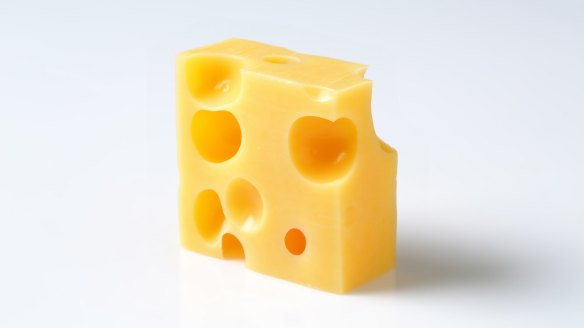How do they put the holes in Swiss cheese?

How do they put the holes in Swiss cheese? T. Perry
For well over a century, Switzerland has been the global capital of tax evasion, pocket knives and trains that go up particularly steep inclines. Switzerland also produces some exceptionally fine cheese. Swiss Emmentaler is a raw cow's milk cheese and has been made in the Emmen Valley since the 13th century. One of the cultures that is added to the milk is Propionibacterium freudenreichii. This is an amazing bug that produces a range of acids, amino acids and peptides as it grows inside the cheese. It also produces carbon dioxide gas inside the still plastic interior of the cheese, forming bubbles of various sizes that become the holes in Swiss cheese. In recent years the Swiss were perplexed that their Emmentaler was not holey enough. Research suggested that small particles of hay, falling into the milk during hand milking, had formed the nucleus around which the gas bubbles formed. As more hygienic methods of milking were introduced, the hay no longer came in contact with the milk, and the bubbles failed to form.
Can wholemeal flour and white flour be used interchangeably in recipes? M. Woodley
Yes and no. You can make a loaf of wholemeal bread, but a gravy thickened with wholemeal flour is something you do when you've run out of the white stuff. Most wholemeal flour is made by milling grains of wheat, removing the bran and germ. These are then milled again and returned to the refined flour. Germ and bran are quite thirsty and soak up a lot of moisture. In baking, the water content of a recipe, or hydration, is described as a percentage of the flour. If a bread recipe asks for 1kg of flour and 700ml of water, that is 70 per cent hydration. If you were using wholemeal flour, you would need about 10-15 per cent more hydration, so 800-850ml of water for 1kg of flour.
As the Netherlands no longer refer to their country as "Holland", can we still call the sauce put on eggs benedict "hollandaise"? L. Bond
You are referring to the fact that the government of The Netherlands has officially rebranded their low-lying nation, dropping the moniker Holland on January 1. I also suspect that you're having a lend of me. Sauce Hollandaise is French for Dutch sauce and refers to the emulsion of melted butter in heated egg yolk acidulated with either lemon juice or vinegar, depending on the chef. The first recipe for Dutch sauce dates back to the 1600s, although there are references to it as early as the mid-1500s. What is interesting to note is that most hollandaise sauces served in cafes these days comes in ready-to-use tubs, and is made with the likes of palm oil, skim milk powder and emulsifiers such as xanthan, guar and locust bean gum. Not good stuff. Ask your waiter if they make their own hollandaise.
Send your vexing culinary conundrums to brainfood@richardcornish.com.au or tweet to @realbrainfood.
Appears in these collections
More:
From our partners
Original URL: https://www.smh.com.au/goodfood/how-do-they-put-the-holes-in-swiss-cheese-20200116-h1l2q0.html
